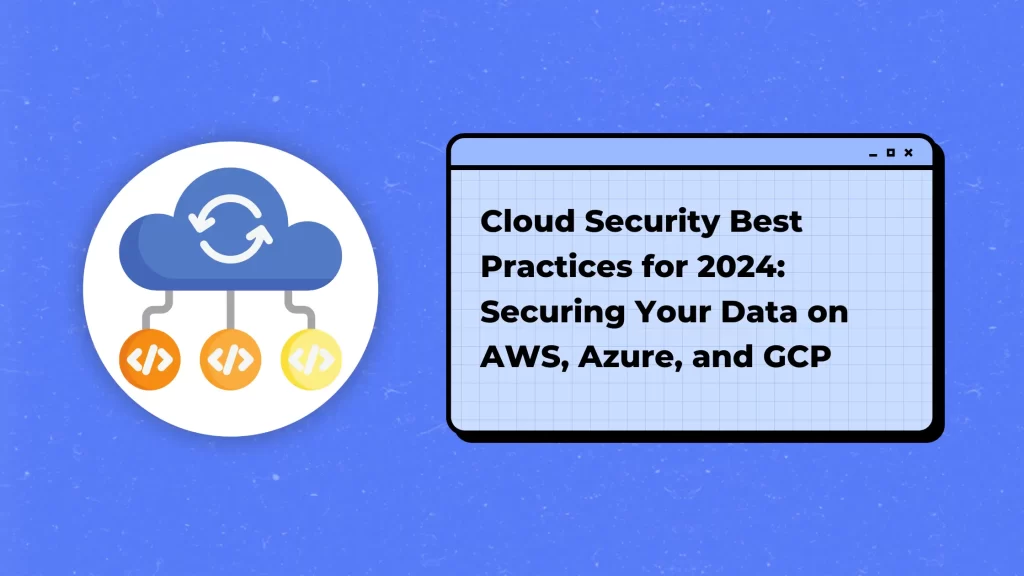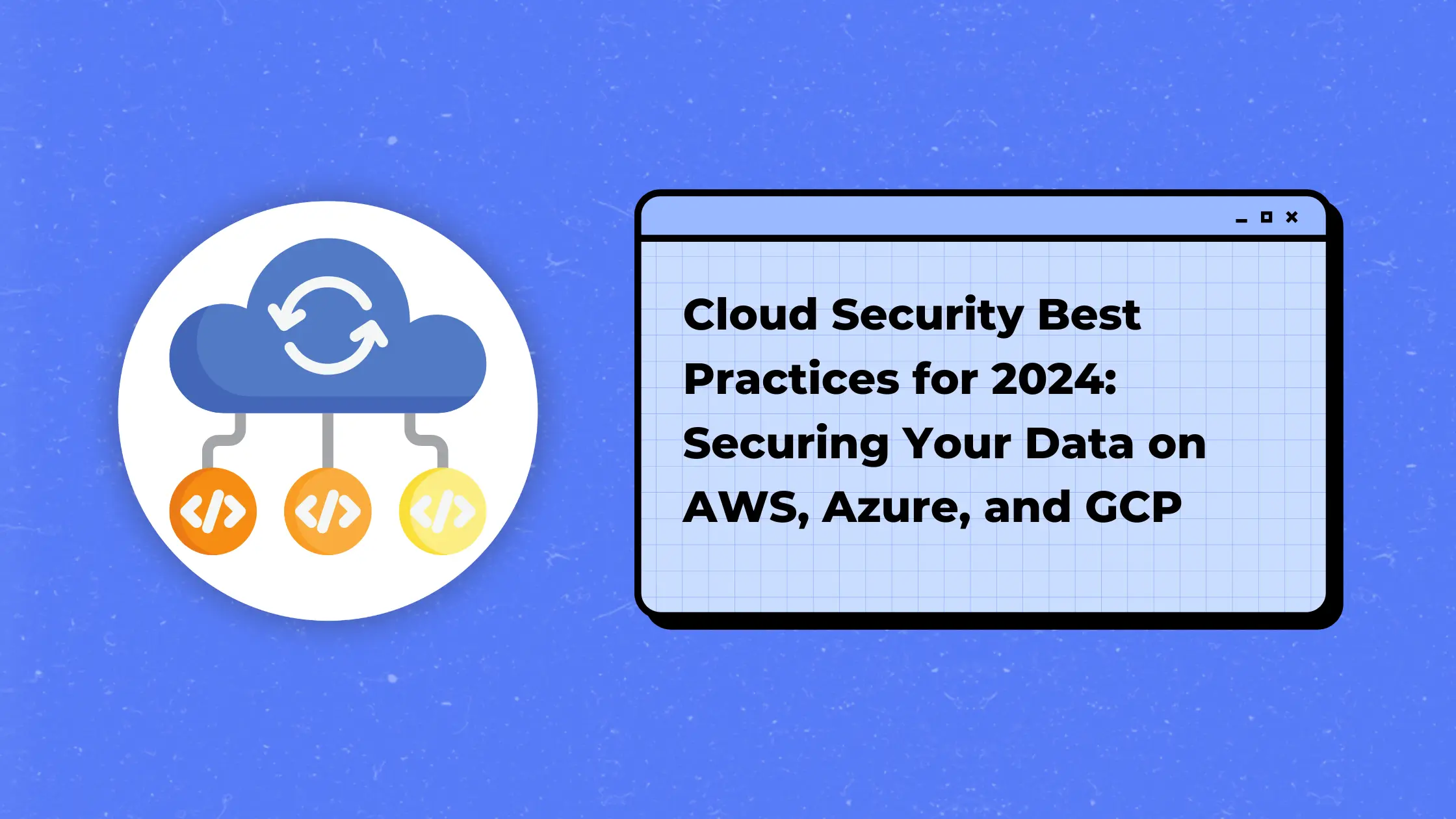
In the rapidly evolving digital landscape, securing data in the cloud has become paramount for businesses of all sizes. As organizations rely more on cloud platforms like AWS, Azure, and Google Cloud Platform (GCP), robust security practices are essential to protect sensitive data and ensure compliance with industry standards. This guide outlines the most effective cloud security best practices for 2024, enabling you to safeguard your data while leveraging the full potential of cloud technology.
Introduction to Cloud Security Best Practices
Cloud computing offers unparalleled scalability, flexibility, and cost savings, but it also presents unique security challenges. While cloud providers implement extensive security measures, the responsibility for data security is shared between the provider and the customer. To ensure your data remains protected, adopting and implementing best practices across AWS, Azure, and GCP is critical.
In this article, we’ll explore essential strategies, tools, and techniques that can enhance cloud security on these platforms, covering identity management, network security, data encryption, and compliance measures.
Understanding the Shared Responsibility Model
Cloud security operates on a shared responsibility model, which means that both the cloud provider and the user play crucial roles in maintaining security.
In general, cloud providers manage:
- Infrastructure Security: The physical security of data centers and the underlying hardware.
- Platform Security: Core software and services.
On the other hand, customers are responsible for:
- Data Protection: Securing applications, databases, and personal data stored in the cloud.
- Identity and Access Management (IAM): Managing who has access to what resources.
Each major cloud provider has slight variations in the shared responsibility model. Here’s a breakdown of how it applies to AWS, Azure, and GCP.
Key Cloud Security Challenges in 2024
With rising sophistication in cyber threats, understanding the security challenges of cloud environments is crucial. Here are some pressing concerns for cloud security in 2024:
- Data Breaches: Unsecured data storage configurations can lead to breaches.
- Insider Threats: Unauthorized access or misuse by employees or contractors.
- Misconfigured Resources: Complex cloud configurations increase the risk of vulnerabilities.
- Insufficient Identity Management: Poor IAM can expose sensitive resources to unauthorized users.
Best Practices for AWS Security in 2024
Implement Identity and Access Management (IAM) Policies
AWS IAM allows you to control access to AWS resources securely. Some best practices include:
- Principle of Least Privilege: Grant only the permissions necessary for each user or role.
- Multi-Factor Authentication (MFA): Enforce MFA for all user accounts, especially privileged users.
- Use IAM Roles: Create and assign roles to applications rather than sharing AWS access keys.
Enable CloudTrail for Comprehensive Auditing
AWS CloudTrail is an essential service for tracking user activity and changes across your AWS environment. By enabling CloudTrail:
- Monitor Account Activity: Get a detailed log of every action taken on your AWS account.
- Set Alerts: Configure alerts for high-risk activities, such as changes to IAM policies.
Apply Encryption for Data at Rest and in Transit
AWS offers multiple encryption options, including server-side encryption with AWS Key Management Service (KMS) and SSL/TLS for data in transit.
- Use AWS KMS: Encrypt sensitive data with keys managed in AWS KMS.
- Enable SSL/TLS: Ensure data is encrypted in transit for all applications.
Utilize Security Groups and Network Access Control Lists (ACLs)
Control access to your network resources by configuring Security Groups and Network ACLs:
- Security Groups: Use these as virtual firewalls for EC2 instances, specifying which IP addresses can access your resources.
- Network ACLs: Implement network ACLs at the subnet level to control incoming and outgoing traffic.
Set Up AWS Config for Compliance Monitoring
AWS Config enables you to assess, audit, and evaluate the configurations of your AWS resources.
- Automated Compliance Checks: Ensure resources remain compliant with security policies.
- Track Changes: Get alerts on any resource changes that deviate from set configurations.
Best Practices for Microsoft Azure Security
Leverage Azure Active Directory (Azure AD) for Identity Management
Azure AD is a comprehensive identity management solution that provides single sign-on (SSO) and multi-factor authentication.
- Conditional Access: Implement Conditional Access policies to allow or deny access based on conditions like user location.
- Use Privileged Identity Management (PIM): Manage, control, and monitor privileged access within Azure AD.
Secure Data with Azure Key Vault
Azure Key Vault helps you safeguard cryptographic keys, passwords, and certificates.
- Centralized Key Management: Store secrets and access them securely within your applications.
- Implement Access Policies: Restrict access to the vault based on roles and policies.
Enable Microsoft Defender for Cloud
Microsoft Defender for Cloud (formerly Azure Security Center) provides advanced threat protection and security recommendations.
- Enable Security Posture Management: Continuously monitor the security state of your resources.
- Threat Detection and Response: Receive alerts on detected vulnerabilities or threats.
Use Network Security Groups (NSGs) and Azure Firewall
Protect Azure resources from unauthorized access by configuring NSGs and Azure Firewall.
- Network Security Groups: Control network traffic to and from your Azure resources.
- Azure Firewall: Set up this fully managed firewall to filter traffic between Azure subnets.
Best Practices for Google Cloud Platform (GCP) Security
Utilize Identity and Access Management (IAM) on GCP
GCP IAM offers granular access control to your resources.
- Define IAM Roles and Policies: Limit permissions to only what each user or service account requires.
- Set Up Two-Factor Authentication (2FA): Require 2FA for sensitive accounts to add an additional layer of security.
Enable Cloud Security Command Center
The Cloud Security Command Center (SCC) is a security and risk management tool on GCP.
- Monitor Asset Security: Identify and mitigate threats with real-time monitoring.
- Vulnerability Scanning: Automatically scan for misconfigurations and potential vulnerabilities.
Encrypt Data Using Cloud Key Management
GCP’s Cloud Key Management Service (KMS) allows you to manage cryptographic keys securely.
- Automate Key Rotation: Set up automatic key rotation to enhance security.
- Use Customer-Managed Encryption Keys (CMEK): Retain control over your encryption keys.
Implement VPC Service Controls for Network Security
GCP’s Virtual Private Cloud (VPC) Service Controls help prevent data exfiltration by restricting access to resources.
- Isolate Sensitive Data: Define service perimeters around sensitive resources.
- Secure APIs and Services: Control which services are accessible within your VPC.
Unified Cloud Security Best Practices Across AWS, Azure, and GCP
Monitor and Log Cloud Activity
Enable logging services on AWS (CloudTrail), Azure (Activity Log), and GCP (Cloud Logging) to track and audit user activity.
- Set Up Centralized Logging: Use a security information and event management (SIEM) system to aggregate logs from multiple platforms.
- Alerting and Notification: Configure alerts for suspicious or high-risk activities.
Automate Security with Infrastructure-as-Code (IaC)
Implementing IaC ensures consistency and security in cloud environments.
- Use Tools Like Terraform or AWS CloudFormation: Automate deployment and configuration of cloud resources.
- Scan IaC Templates for Vulnerabilities: Identify potential security risks before deploying resources.
Regularly Update and Patch Cloud Resources
Outdated software and resources can introduce vulnerabilities.
- Automated Patch Management: Use native tools on each platform, such as AWS Systems Manager Patch Manager, Azure Update Management, and GCP’s OS patch management.
- Apply Patches Consistently: Ensure all systems, applications, and dependencies are up to date.
Establish a Data Backup and Recovery Plan
Data loss can occur due to human error, ransomware, or hardware failure.
- Automate Backups: Use AWS Backup, Azure Backup, and GCP’s backup solutions to schedule regular data backups.
- Test Recovery Procedures: Regularly test your data recovery plans to ensure they work in a crisis.
Advanced Cloud Security Techniques for 2024
With the rise of artificial intelligence (AI) and machine learning (ML), incorporating these technologies into security strategies offers several advantages.
AI-Powered Threat Detection
Use AI tools to analyze vast amounts of data and detect patterns indicating potential security threats.
Zero Trust Architecture
Adopt a Zero Trust model, where every access request is verified, regardless of its origin.
Security Automation and Orchestration
Automate routine security tasks to reduce human error and respond faster to threats.
Conclusion
Securing your data on AWS, Azure, and GCP requires a proactive approach and a comprehensive understanding of each platform’s security features. By implementing these cloud security best practices for 2024, you can protect sensitive data, prevent unauthorized access, and minimize the risk of cyber threats. As cloud technology evolves, staying updated on the latest security advancements and adapting your security measures is essential to safeguarding your data in an increasingly digital world.
Frequently Asked Questions
What is the shared responsibility model in cloud security?
The shared responsibility model in cloud security is a framework that defines the division of security responsibilities between the cloud service provider and the customer. Cloud providers, such as AWS, Azure, and GCP, handle the security of the underlying infrastructure, which includes hardware, software, networking, and data centers. This typically covers physical security, availability, and some platform-level security features.
On the other hand, customers are responsible for securing everything they put into the cloud, including their data, applications, user access controls, and network configurations. For example, setting up firewalls, managing identities and access, and implementing encryption measures fall on the customer. This model ensures clarity in responsibilities and requires both parties to work together to maintain overall security.
How can I secure data on AWS, Azure, and GCP?
Securing data on AWS, Azure, and GCP involves a combination of identity management, data encryption, network security, and regular monitoring. Some essential steps include:
- Identity and Access Management (IAM): Set up IAM policies to manage who has access to what resources, and use Multi-Factor Authentication (MFA) to protect access.
- Data Encryption: Encrypt data at rest and in transit to prevent unauthorized access. All three platforms provide robust encryption services, like AWS KMS, Azure Key Vault, and GCP Cloud KMS.
- Network Security: Configure firewalls, Network Security Groups (NSGs), and other security settings to control access to resources within your cloud environment.
- Logging and Monitoring: Use tools like AWS CloudTrail, Azure Security Center, and GCP Security Command Center to log and monitor cloud activities. These tools help detect and respond to suspicious activities in real time.
- Regular Audits: Perform frequent security audits and compliance checks to ensure your configuration aligns with security policies and best practices.
By following these steps, you can greatly enhance data security across AWS, Azure, and GCP environments.
What tools are available for threat detection on cloud platforms?
Each major cloud provider offers comprehensive tools for detecting and responding to threats:
- AWS: AWS GuardDuty is a managed threat detection service that monitors for malicious activity and unauthorized behavior across AWS environments. AWS Security Hub centralizes threat intelligence and security alerts to streamline security management.
- Azure: Microsoft Defender for Cloud provides continuous threat monitoring, vulnerability assessments, and alerts across Azure services. Azure Sentinel, a security information and event management (SIEM) solution, offers analytics and intelligence-driven threat detection.
- GCP: Google Cloud Security Command Center (SCC) offers a comprehensive view of security threats, with features like asset discovery, misconfiguration detection, and real-time monitoring.
These tools leverage machine learning and data analytics to detect anomalies, allowing for timely threat detection and response.
Is multi-factor authentication (MFA) necessary for cloud security?
Yes, Multi-Factor Authentication (MFA) is crucial for cloud security. MFA adds an extra layer of protection by requiring users to verify their identity through multiple methods, such as entering a password and then confirming via a mobile app or SMS code.
Even if a password is compromised, MFA can help prevent unauthorized access to cloud resources. Enforcing MFA, especially for privileged accounts and administrators, is considered one of the most effective ways to reduce the risk of unauthorized access.
What role does encryption play in cloud security?
Encryption is a core element of cloud security that protects data from unauthorized access by transforming it into an unreadable format. It plays a significant role in safeguarding sensitive information both at rest (stored data) and in transit (data being transferred).
Cloud platforms like AWS, Azure, and GCP offer encryption services that allow you to:
- Encrypt data at rest using managed encryption keys or bring-your-own-key (BYOK) options.
- Encrypt data in transit using SSL/TLS protocols to prevent interception during transmission.
- Store and manage encryption keys securely with services like AWS KMS, Azure Key Vault, and GCP Cloud KMS.
Encryption helps maintain data confidentiality, even in cases where data might be accessed or transferred across networks.
What is the importance of Infrastructure-as-Code (IaC) in cloud security?
Infrastructure-as-Code (IaC) involves managing and provisioning cloud infrastructure using machine-readable configuration files, rather than manual processes. This approach improves security in several ways:
- Consistency: IaC reduces human errors by ensuring consistent configurations across deployments, which reduces security vulnerabilities.
- Version Control: IaC files can be versioned and stored in a source control system, providing an audit trail of changes. This is particularly helpful for identifying and mitigating potential security issues related to configuration drift.
- Automated Security Checks: IaC allows you to automate security checks in your deployment pipeline, enabling you to catch misconfigurations before they reach production.
- Scalability: IaC simplifies scaling cloud infrastructure, allowing security settings to be applied consistently as new resources are added.
Using tools like AWS CloudFormation, Azure Resource Manager (ARM) templates, and Terraform can streamline security management and improve the reliability of cloud infrastructure configurations.


